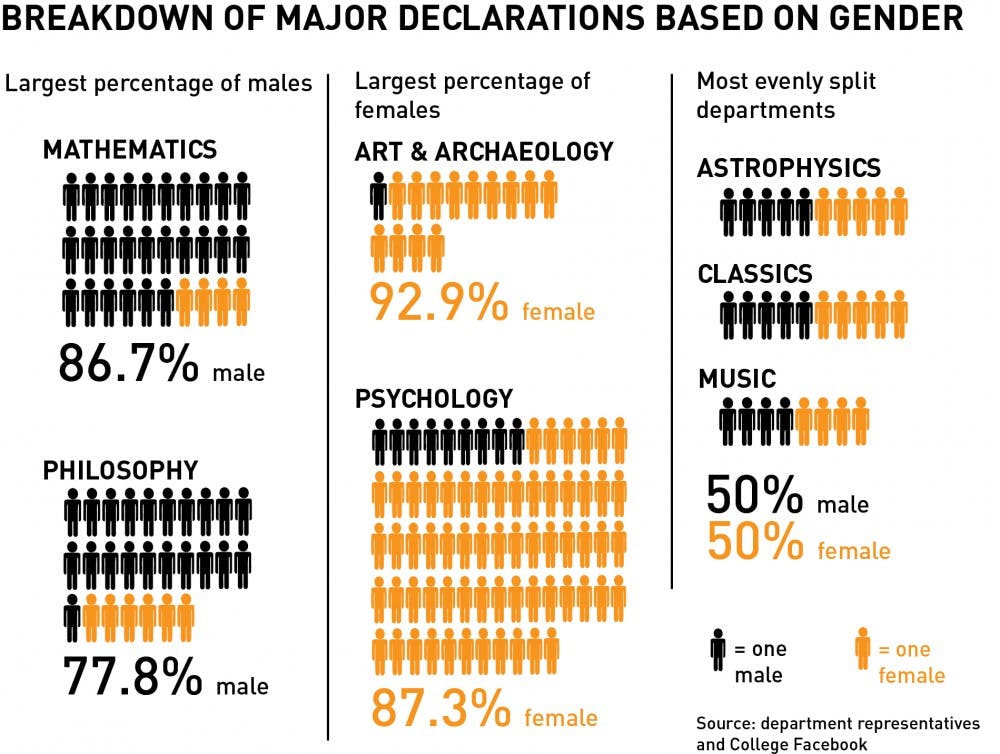While bachelor's degree concentration declarations for the Class of 2016 were predominantly male in the science, technology, engineering and math fields, the gender distribution was roughly even in the social sciences and the humanities.
Female A.B. sophomores declared at the highest percentages in art and archaeology at 92.9 percent, psychology at 87.3 percent and comparative literature at 81.3 percent.
Representatives for these departments declined to comment or did not respond to requests for comment.
English had a 70.8 percent female sophomore class, and was the second most popular humanities concentration after the history department, which had an even gender distribution. English departmental representative Sophie Gee said she does not consider the disparity a problem and added that she likes the fact that English draws intelligent female students. She attributed the trend in part to the strong mentorship of female faculty.
"English is a discipline where smart young women are able to feel comfortable, feel welcome," she said.
Molecular biology was the only STEM major in which a female majority declared, at two-thirds of those declaring. Departmental representative Thomas Silhavy noted that while the imbalance has long existed across the nation, the proportion of women at the University seems to be creeping up. Women may find biology inherently more interesting than the physical sciences or look to the many female faculty members as role models, he said.
Silhavy said the department does not have plans to attract more male concentrators, adding jokingly that having more women could attract more men.

Departments with over five concentrators with the highest male percentages were mathematics at 86.7 percent male, philosophy at 77.8 percent male, A.B. computer science at 77.3 percent male and physics at 76.2 percent male.
Mathematics departmental representativeJános Kollár said he believes much of the imbalance starts in elementary school, when teachers present mathematics as a collection of recipes. This imbalance, he said, can only be addressed in a limited way at the university level.
"Maybe people think that the mathematician is just like a computer who happens to have two legs and two arms is a more negative image to women than to men,” he said. “I think it's a negative image to everyone, but it might be especially off-putting to young women.”
A.B. computer science was 77.3 percent male, similar to the B.S.E. rate of 76.3 percent. The department contains a slightly higher proportion of women than the national average of around 19 percent.

Departmental representative David Walker said University courses such as COS 126: General Computer Science broaden the appeal of the discipline.
"We illustrate in our introductory courses all the range of different things that involve what I would call computational thinking — thinking algorithmically, thinking using procedures, and all the applications of that mode of thought — applications in medicine, applications in mathematics, applications in art," he said. He added that he expects the successes of female computer science majors to draw more women to the department.
Physics departmental representative Christopher Tully and philosophy departmental representative John Burgess declined to comment.
Sophomores declared majors in the social sciences, including sociology, politics, the Wilson School, East Asian Studies and Near Eastern Studies, at mostly even rates. The exceptions were economics at 64.4 percent male, anthropology at 72.7 percent female and psychology at 87.3 percent female.
Anthropology departmental representative Isabelle Clark-Decès did not respond to a request for comment. The data for the anthropology department was compiled from unofficial numbers obtained from College Facebook.
Economics department representative Smita Brunnermeier noted that equal numbers of entering freshmen list economics as a prospective concentration, but added that the proportion changes by the time students declare in their sophomore year. She noted an even worse imbalance for graduate students and faculty.
Women with broad interests might avoid economics because they mistakenly believe the discipline only leads to careers in finance, she said.
"Maybe we should be doing a better job of communicating to young female students that the methodological tools — econometrics, statistics, the modeling techniques that we teach — can be used in a wide of variety of applications, and are very applicable to topics of social importance," she said, adding that the department could close the gap by reaching out at underclassman open houses to discuss the variety of research and jobs pursued by majors.
According to data provided by Brunnermeier, the male distribution of the economics department peaked at 73 percent for the Class of 2009 and reached its lowest point in the last nine rounds of concentrations at 58 percent for the Class of 2013.
The language departments, which received the smallest numbers of concentrators, saw male majorities or even gender distributions. German had four males and one female, French & Italian had three males and one female, Spanish & Portuguese had one female and one male and Slavic Languages & Literatures had one male.
Staff writer Do-Hyeong Myeong contributed reporting.








